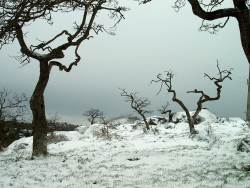 |
 |
| Home | Welcome | What's New | Site Map | Glossary | Weather Doctor Amazon Store | Book Store | Accolades | Email Us |
 | |||||||||
Weather Almanac for March 2004THE WEATHER GLASSOn my wall hangs a glass vessel looking like a stretched teapot, a Christmas gift from my mother. To its far left hangs an electronic barometer; to its right sits a desktop aneroid barometer. Fitting perhaps, since this glass vessel is a style of barometer that has hung in homes for centuries. Known by many names including the weather glass, storm glass, and water barometer, it offers an aid to simple weather forecasting by showing pressure changes as water rises or falls in its "spout."
One of the most famous weather glass users was the German poet and writer Johan Wolfgang Goethe (1749-1832) who took a great interest in weather. (Goethe was also the first to promote the cloud classification scheme of Luke Howard on the European continent.) His personal weather glass continues to hang in his former home (now is a museum) in Weimar, Germany. During his travels around Europe, Goethe discovered the glass and introduced it to the German-speaking countries. His promotion of the instrument linked it to him and became known as the Goethe barometer. The Design and Theory
The glass should be mounted in a location out of the sun and where the surrounding temperature is stable, because it also acts as a thermometer as the water expands when heated and contracts when cooled. When properly filled, the weather glass has a large bubble of air in the bottle that reflects the air pressure at the time of filling. The water level in the tulle rises and falls in response to changes in the air pressure. Because the width of the bottle is much greater than the width of the tulle, changes in the water level are amplified, making the pressure change over time quite apparent to those observing it. Unlike mercury, aneroid, and electronic barometers, the weather glass barometer is not good for recording absolute air pressure. However, it proves useful for observing air pressure tendencies, that we can use to make a local weather forecast. The pressure in the closed end of the bottle sets the "base" level, and initially the water levels in the bottle and tulle are the same. When the external air pressure falls, the inequity of the two pressures — internal versus external — causes the water level in the tulle to rise. Conversely, when the external air pressure rises, it forces the water back down the tulle into the bottle and the level in the tulle falls. [If the bottle is exposed to conditions that may heat or cool the water within the bottle, such as placement in the sun, the water will expand when heated and will contract when cooled. This will send water in the tulle up or down, respectively and confound the observations of pressure changes.] I have written elsewhere about the use of the barometer, with or without other weather observations, in producing local, short-term weather forecasts through the observation of the tendency of the barometric pressure over a few hours time. (For the details, go to Applying The Barometer To Weather Watching.) Suffice it to say here that, in general, a rise in the water level in the tulle foretells deteriorating weather conditions and increased likelihood of precipitation. A falling water level signifies clearing conditions and coming fair weather. In some situations, a rapidly advancing storm may push the water level so high that it spills over into the dropcatcher under the bottle. While the weather glass is not the most accurate means of measuring air pressure changes available to the non-professional today — nor always the least expensive — it certainly has an elegant simplicity that makes it a highly decorative piece. I enjoy checking the water level as I pass my instrument, and it always make a fine conversation piece when visitors ask what it is. I then can relate its long history and practical usage. For those interested, a weather glass can be purchased through many different outlets (garden shops, science stores, etc.) ranging in price from $US20 on up, depending on the workmanship of the bottle and its wall mount. One on-line market is Wind & Weather which you can access by clicking the name and going to the Water Barometer page linked from the Weather Instrument Page. Written by
|
|||||||||
 |
To Purchase Notecard, |
Now Available! Order Today! | |
 |
 |
NEW! Now |
The BC Weather Book: |


